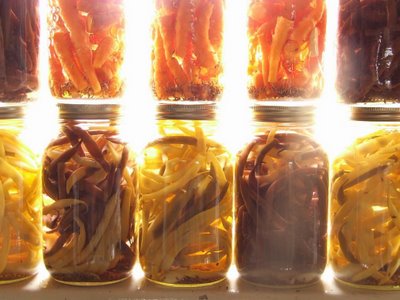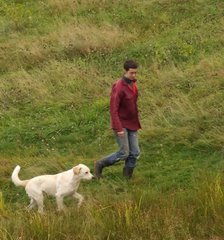
The first time I canned beans, it seemed like a miracle. In the Spring that year, my husband and I had hillled the soil, trading off the backpack containing our sleeping youngest child. I'd planted the smooth, oblong beans, not quite trusting that they would amount to... well... a hill of beans. When the little plants broke through the soil and began to unfurl themselves, I was jubilant. And when, many weeks later, I lifted the leaves and found long, brightly-colored beans where none had been only a few days before, I felt an absurd sense of accomplishment.
Pride turned quickly to dismay, as I carted laundry baskets full of yellow, green, and purple beans up to the house. I'd planted "a few extra beans, just in case some don't come up", only to have every blessed plant produce like crazy. And now, they were taking over the kitchen, piled in baskets and buckets and boxes, tumbling out of bags. The problem was, I'd only ever eaten them steamed, with butter. The entire family and half the community would have to eat steamed beans three times a day for the next month, to deal with this bounty!
And so, the pickling began. After the first few jars, I hit on a rhythm: put the jars in water to sterilize; wash the beans and boil water to blanch them; prepare the brine solution; blanch, rinse, and pack the beans in jars; add heads of dill and cloves of garlic; pour the brine, and seal. It was labour intensive, but pleasant - the kitchen was filled with a pungent, comforting steam. Pots hissed on the stove; jar lids popped.
When it was all done, I had a table full of beautiful food that I knew would help see us through the winter. And that, for me, was the miracle - the thought that I knew where our food had come from, and that we had been involved in it from seed to table. I knew exactly what the weather was doing on the day the seeds went in the ground. I'd felt the beans slip from my fingers into the soil. We'd kept the weeds at bay by hand, and knew that the soil and the growing plants were free of pesticides. I knew how the beans had travelled from the garden to my kitchen, and how they found their way into bottles in my cupboard. And I knew that, when winter came and the garden was barely a memory, those beans would taste like ambrosia.


9 comments:
What a great picture! Your account of life on the farm should be a book - It's great - you got beauty, passion, humour all wrapped into one package - I really enjoy your blog
Love Gwen
Thanks, Gwen. I'm really enjoying writing it. And my spouse's photos are awesome - they're often the inspiration behind the post.
Lovely photo. For me there is little better than opening a jar of dill pickles in the middle of winter that has finally absorbed enough flavour from they're summer canning. Keep up the good work and happy harvesting.
Hello, burdockboy - thanks for commenting. Your apple-plum spread looks very tasty! We have a ton of apples... but only one plum thus far. Oh well - there's always next year!
Wow! What an excellent surprise! Yes, we'd sorta been thinking you two might venture up here this summer - but we also know how challenging it can be to leave the farm. Whenever you make it, you'll be welcome! (And hey... I'd love an email update, some time :))
Love, Kate
I love these pictures. The light shining through.... I love your storytelling.
Thanks, Emme. We've been enjoying your blog, as well. BTW, I long ago trained in graphic design (just a one year diploma). Glad to hear you're trying to get your students to think about ethics - something that was abyssmally lacking in the course I took!
hiya, just came across this, just wondering what you use to make the brine solution?
Best,
J
I often make my own preserves from what I grow in the garden, fuits and veg get preserved or pickles and it is a good way to save a liitle cash.
Post a Comment